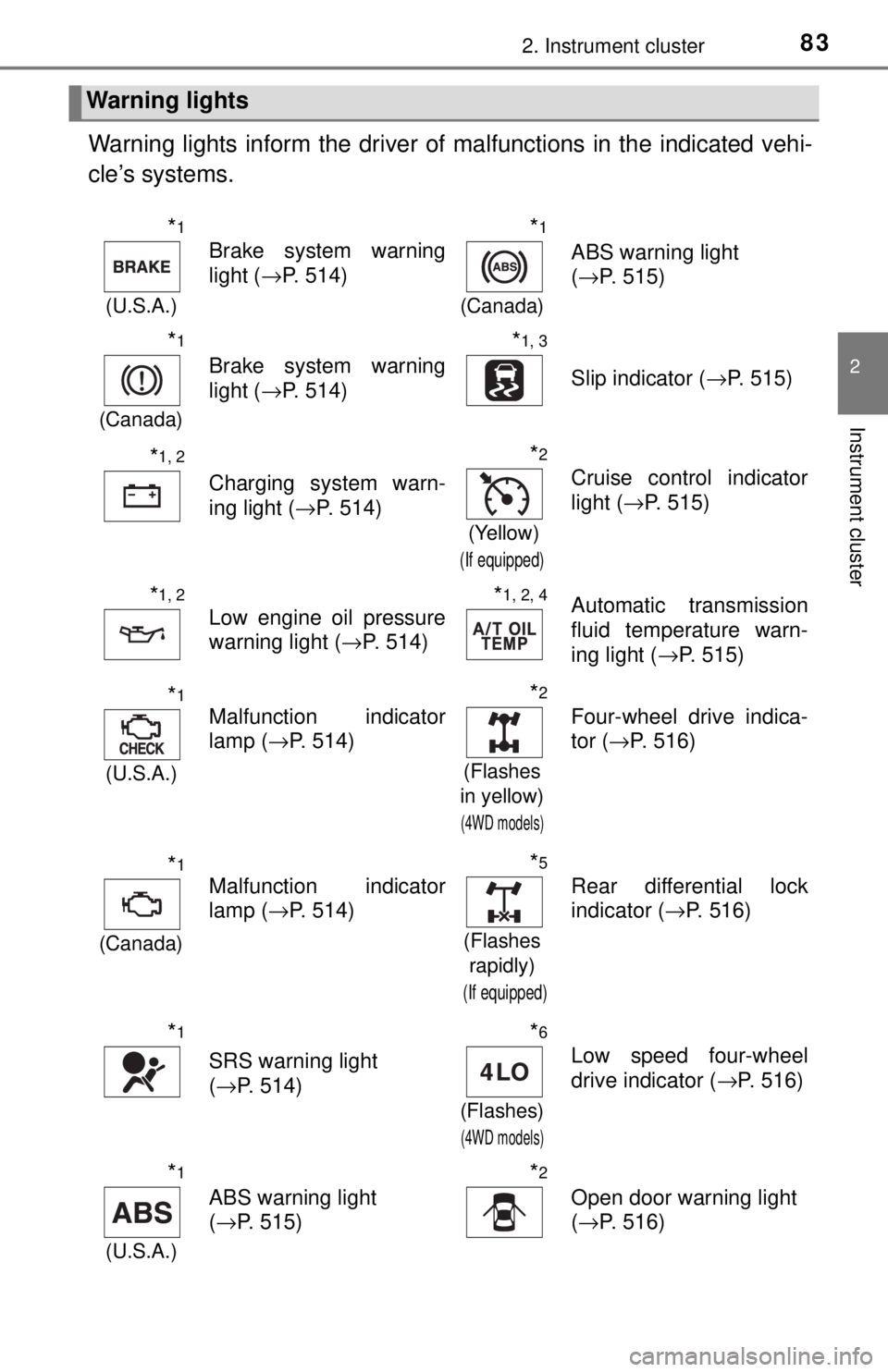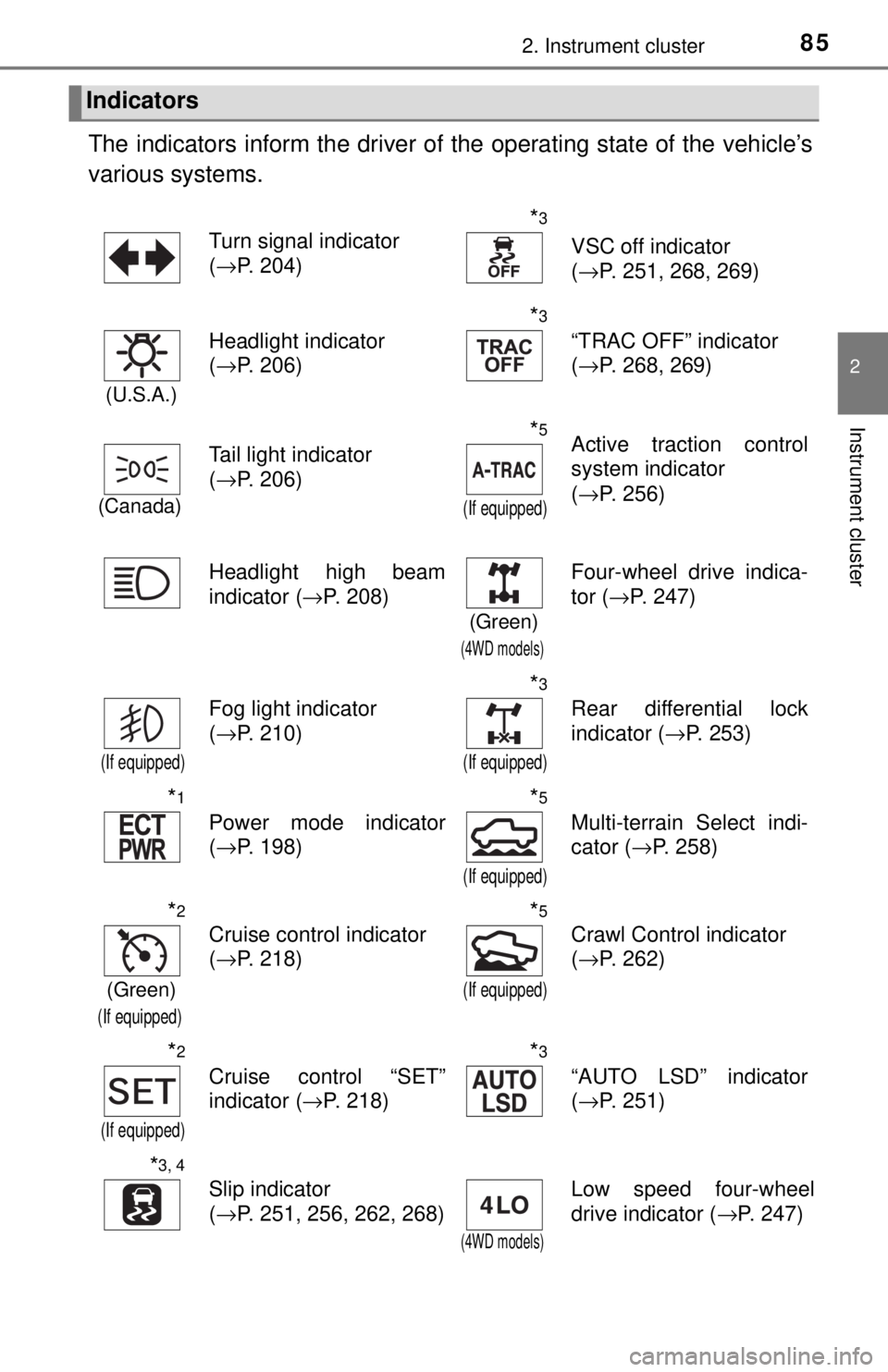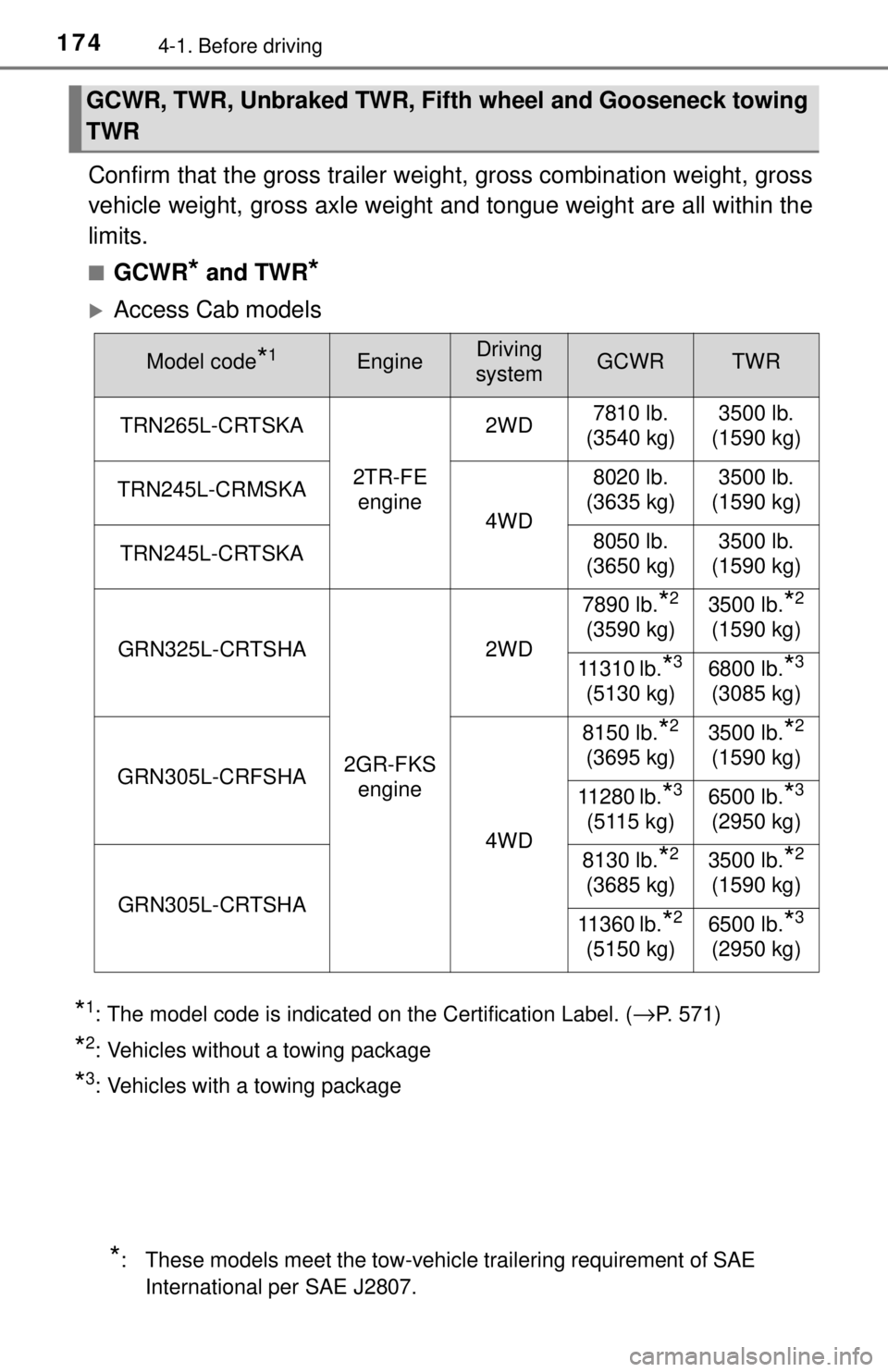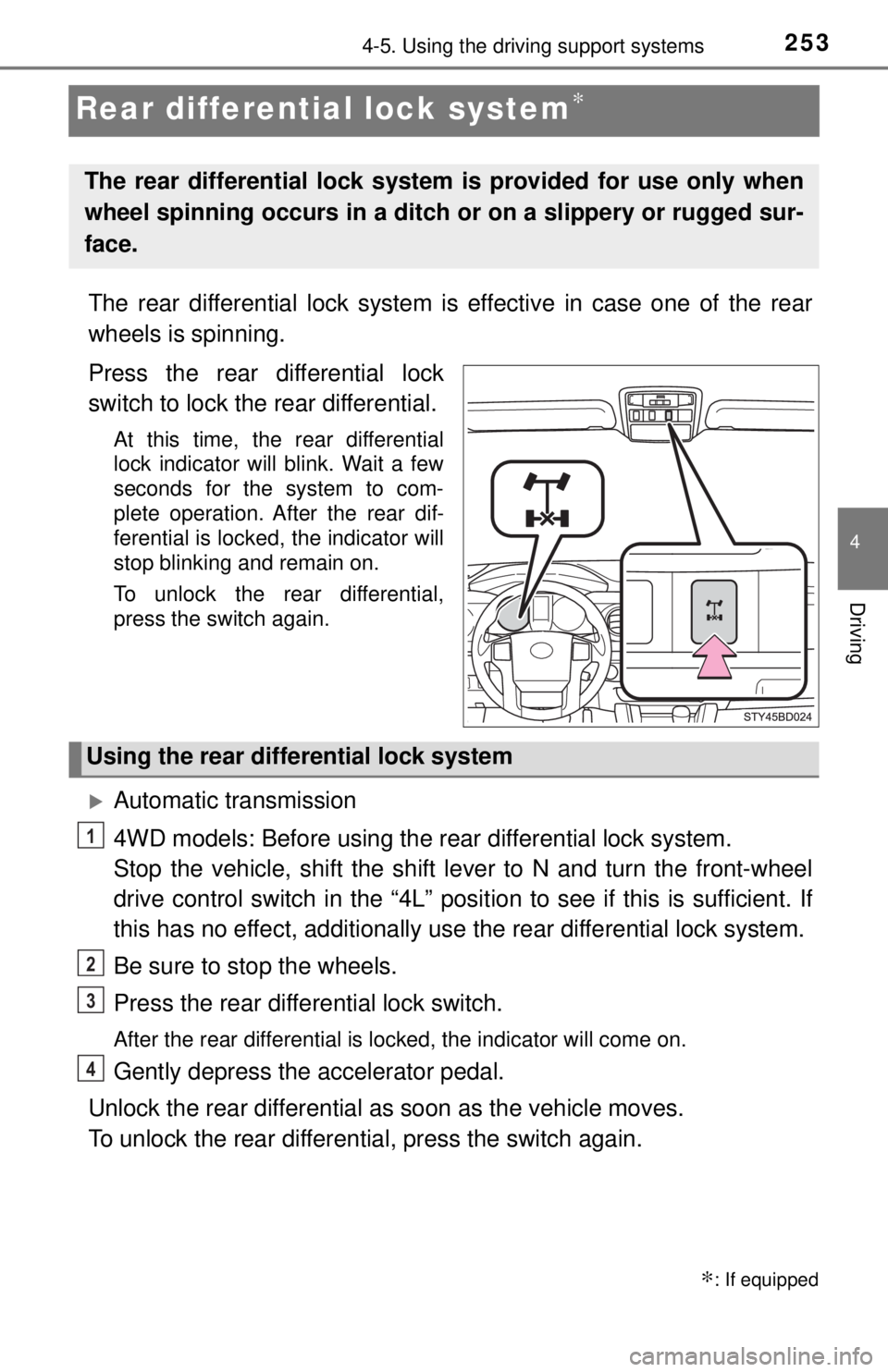Page 83 of 640

832. Instrument cluster
2
Instrument cluster
Warning lights inform the driver of malfunctions in the indicated vehi-
cle’s systems.
Warning lights
*1
(U.S.A.)
Brake system warning
light ( →P. 514)
*1
(Canada)
ABS warning light
(→P. 515)
*1
(Canada)
Brake system warning
light ( →P. 514)
*1, 3
Slip indicator ( →P. 515)
*1, 2
Charging system warn-
ing light (→P. 514)
*2
(Yellow)
(If equipped)
Cruise control indicator
light (→P. 515)
*1, 2
Low engine oil pressure
warning light ( →P. 514)*1, 2, 4Automatic transmission
fluid temperature warn-
ing light ( →P. 515)
*1
(U.S.A.)
Malfunction indicator
lamp (→P. 514)
*2
(Flashes
in yellow)
(4WD models)
Four-wheel drive indica-
tor ( →P. 516)
*1
(Canada)
Malfunction indicator
lamp ( →P. 514)
*5
(Flashes
rapidly)
(If equipped)
Rear differential lock
indicator ( →P. 516)
*1
SRS warning light
(→P. 514)
*6
(Flashes)
(4WD models)
Low speed four-wheel
drive indicator ( →P. 516)
*1
(U.S.A.)
ABS warning light
(→P. 515)
*2
Open door warning light
(→P. 516)
Page 85 of 640

852. Instrument cluster
2
Instrument cluster
The indicators inform the driver of the operating state of the vehicle’s
various systems.
Indicators
Turn signal indicator
( →P. 204)*3
VSC off indicator
(→P. 251, 268, 269)
(U.S.A.)
Headlight indicator
(→P. 206)
*3
“TRAC OFF” indicator
(→P. 268, 269)
(Canada)
Tail light indicator
(→P. 206)
*5
(If equipped)
Active traction control
system indicator
(→P. 256)
Headlight high beam
indicator ( →P. 208)
(Green)
(4WD models)
Four-wheel drive indica-
tor (→P. 247)
(If equipped)
Fog light indicator
(→P. 210)
*3
(If equipped)
Rear differential lock
indicator ( →P. 253)
*1
Power mode indicator
(→P. 198)
*5
(If equipped)
Multi-terrain Select indi-
cator ( →P. 258)
*2
(Green)
(If equipped)
Cruise control indicator
(→P. 218)*5
(If equipped)
Crawl Control indicator
(→P. 262)
*2
(If equipped)
Cruise control “SET”
indicator ( →P. 218)
*3
“AUTO LSD” indicator
(→P. 251)
*3, 4
Slip indicator
(→P. 251, 256, 262, 268)
(4WD models)
Low speed four-wheel
drive indicator ( →P. 247)
Page 164 of 640

1644-1. Before driving
NOTICE
■If you get a flat tire while driving
A flat or damaged tire may cause the following situations. Hold the steering
wheel firmly and gradually depress the brake pedal to slow down the vehi-
cle.
● It may be difficult to control your vehicle.
● The vehicle will make abnormal sounds or vibrations.
● The vehicle will lean abnormally.
Information on what to do in case of a flat tire ( →P. 540)
■ When encounterin g flooded roads
Do not drive on a road that has flooded after heavy rain, etc. Doing so may
cause the following serious damage to the vehicle:
● Engine stalling
● Short in electrical components
● Engine damage caused by water immersion
In the event that you drive on a flooded road and the vehicle is flooded, be
sure to have your Toyota dealer check the following:
● Brake function
● Changes in quantity and quality of oil and fluid used for the engine, trans-
mission, transfer (4WD models) differentials, etc.
● Lubricant condition for the propeller shaft, bearings and suspension joints
(where possible), and the function of all joints, bearings, etc.
Page 174 of 640

1744-1. Before driving
Confirm that the gross trailer weight, gross combination weight, gross
vehicle weight, gross axle weight and tongue weight are all within the
limits.
■GCWR* and TWR*
Access Cab models
*1: The model code is indicated on the Certification Label. (→P. 571)
*2: Vehicles without a towing package
*3: Vehicles with a towing package
GCWR, TWR, Unbraked TWR, Fifth wheel and Gooseneck towing
TWR
*: These models meet the tow-vehicle trailering requirement of SAE International per SAE J2807.
Model code*1EngineDriving
systemGCWRTWR
TRN265L-CRTSKA 2TR-FE engine 2WD
7810 lb.
(3540 kg) 3500 lb.
(1590 kg)
TRN245L-CRMSKA 4WD8020 lb.
(3635 kg) 3500 lb.
(1590 kg)
TRN245L-CRTSKA 8050 lb.
(3650 kg) 3500 lb.
(1590 kg)
GRN325L-CRTSHA
2GR-FKS engine 2WD
7890 lb.
*2
(3590 kg) 3500 lb.*2
(1590 kg)
11310 lb.
*3
(5130 kg) 6800 lb.*3
(3085 kg)
GRN305L-CRFSHA 4WD8150 lb.
*2
(3695 kg) 3500 lb.*2
(1590 kg)
11280 lb.
*3
(5115 kg) 6500 lb.*3
(2950 kg)
GRN305L-CRTSHA 8130 lb.
*2
(3685 kg) 3500 lb.*2
(1590 kg)
11360 lb.
*2
(5150 kg) 6500 lb.*3
(2950 kg)
Page 176 of 640
1764-1. Before driving
*1: The model code is indicated on the Certification Label. (→P. 571)
*2: Vehicles without a towing package
*3: Vehicles with a towing package
■
Unbraked TWR*
1000 lb. (450 kg)
■Fifth wheel and gooseneck towing TWR*
Toyota does not recommend fifth wheel and gooseneck towing.
Model code*1EngineDriving
systemGCWRTWR
GRN305L-PRFSHA
2GR-FKS engine 4WD8270 lb.
*2
(3750 kg)
3500 lb.
*2
(1590 kg)
11300 lb.
*3
(5125 kg) 6400 lb.
*3
(2900 kg)
GRN305L-PRTSHA 8250 lb.
*2
(3740 kg)
3500 lb.
*2
(1590 kg)
11280 lb.
*3
(5115 kg) 6400 lb.
*3
(2900 kg)
GRN305L-PRTLHA 8310 lb.
*2
(3765 kg)
3500 lb.
*2
(1590 kg)
11330 lb.
*3
(5135 kg) 6400 lb.
*3
(2900 kg)
GRN310L-PRTSHA 8310 lb.
*2
(3765 kg)
3500 lb.
*2
(1590 kg)
11330 lb.
*3
(5135 kg) 6400 lb.
*3
(2900 kg)
GRN310L-PRTLHA 8360 lb.
*2
(3790 kg)
3500 lb.
*2
(1590 kg)
11090 lb.
*3
(5030 kg) 6000 lb.
*3
(2720 kg)
*: These models meet the tow-vehicle trailering requirement of SAE
International per SAE J2807.
Page 221 of 640

2214-5. Using the driving support systems
4
Driving
■Cruise control can be set when
●Vehicles with an automatic transmission: The shift lever is in D or range 4 or
higher of S has been selected.
● Vehicle speed is above approximately 25 mph (40 km/h).
■ Accelerating after setting the vehicle speed
●The vehicle can be accelerated normally. After acceleration, the set speed
resumes.
● Even without canceling the cruise control, the set speed can be increased
by first accelerating the vehicle to the desired speed and then pushing the
lever down to set the new speed.
■ Automatic cruise control cancellation
Cruise control will stop maintaining the vehicle speed in any of the following
situations.
●Actual vehicle speed falls more than approximately 10 mph (16 km/h) below
the preset vehicle speed.
At this time, the memorized set speed is not retained.
● Actual vehicle speed is below approximately 25 mph (40 km/h).
● VSC is activated.
● TRAC is activated for a period a time.
● When the VSC or TRAC system is turned off by pressing the VSC off switch.
● 4WD models: The operation cannot be switched for 5 seconds or more after
operating the front-wheel drive control switch.
■ If the cruise control indicator light comes on in yellow (vehicles without
a multi-information display)
Press the “ON-OFF” button once to deactivate the system, and then press
the button again to reactivate the system.
If the cruise control speed cannot be set or if the cruise control cancels imme-
diately after being activated, there may be a malfunction in the cruise control
system. Have the vehicle inspected by your Toyota dealer.
■ If the warning message for the crui se control is shown on the multi-
information display (vehicles wi th a multi-information display)
Press the “ON-OFF” button once to deactivate the system, and then press
the button again to reactivate the system.
If the cruise control speed cannot be set or if the cruise control cancels imme-
diately after being activated, there may be a malfunction in the cruise control
system. Have the vehicle inspected by your Toyota dealer.
Page 251 of 640
2514-5. Using the driving support systems
4
Driving
AUTO LSD system
The system can be used on 2WD models and in 2WD mode on 4WD
models.
Press the VSC off switch to turn
on the system.
At this time, the “AUTO LSD” and
VSC off indicators will come on
simultaneously.
To turn off the system, push the
switch again.
If the engine is turned off while the
“AUTO LSD” indicator is on and
then restarted, the indicator will
turn off automatically.
If the rear wheels spin, the slip
indicator flashes to indicate that
the AUTO LSD system has been
controlled the spinning of the rear
wheels.
The AUTO LSD system aids traction by using the traction con-
trol system to control engine performance and braking when
one of the rear wheels begins to spin.
The system should be used only when one of the rear wheels
spinning occurs in a ditch or rough surface.
System operation
When the AUTO LSD system is operating
Page 253 of 640

2534-5. Using the driving support systems
4
Driving
Rear differential lock system∗
The rear differential lock system is effective in case one of the rear
wheels is spinning.
Press the rear differential lock
switch to lock the rear differential.
At this time, the rear differential
lock indicator will blink. Wait a few
seconds for the system to com-
plete operation. After the rear dif-
ferential is locked, the indicator will
stop blinking and remain on.
To unlock the rear differential,
press the switch again.
Automatic transmission
4WD models: Before using the rear differential lock system.
Stop the vehicle, shift the shift lever to N and turn the front-wheel
drive control switch in the “4L” position to see if this is sufficient. If
this has no effect, additionally use the rear differential lock system.
Be sure to stop the wheels.
Press the rear differential lock switch.
After the rear differential is locked, the indicator will come on.
Gently depress the accelerator pedal.
Unlock the rear differential as soon as the vehicle moves.
To unlock the rear differential, press the switch again.
∗: If equipped
The rear differential lock system is provided for use only when
wheel spinning occurs in a ditch or on a slippery or rugged sur-
face.
Using the rear differential lock system
1
2
3
4